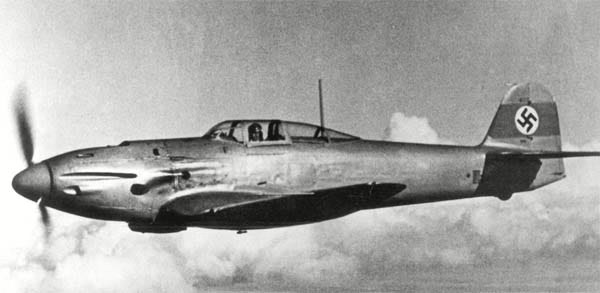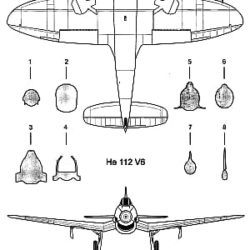Heinkel He 112 History
The Heinkel He 112 was evolved in the mid-1930s as a contender to vie with the Messerschmitt Bf 109 and others for Luftwaffe orders, and from the aesthetic viewpoint at least was a more attractive aeroplane than now-famous contemporary. The He 112 was a sturdy low-wing monoplane with an inverted gull wing of semi-elliptical planform and exceptionally broad chord. The deep-section fuselage with its large open cockpit afforded the pilot a good view when taxi-ing, and the wide-track retractable undercarriage eased ground handling problems. The oval-section monocoque fuselage and two-spar wing were built of metal and covered in flush-riveted stressed metal skin.
Like the Bf 109, the He 112V1 first prototype (D-IADO) was also powered by a Rolls-Royce Kestrel V engine, although the Junkers Jumo 210 was the powerplant for which it had been designed. It flew for the first time in the summer of 1935, being followed in November by a Jumo-engined second prototype with a 3 ft 3 ¼ in (1.00 m) shorter wing span and a third, armed machine similar to the second. Two 7.9 mm MG machine-guns were installed in the V3, which was later fitted with a new wing of full elliptical planform, and a sliding cockpit canopy. The He 112V4, V5, V6 and V8 were completed as prototypes for an He 112A production model, the last of these four having a 1,000 hp DB 600A engine. In the event, however, the He 112A version was not built; the first to go into production was the Heinkel He 112B, based upon the V7 and V9 prototype aircraft. A batch of thirty He 112B-0s was built, and these were delivered to the Luftwaffe for service trials in 1938. Later that year seventeen of them flown by German crews, carried out a brief period of operations with Grupo 5-G-5 of the Spanish Nationalist forces in the Civil War. All but two of these survived that war to serve in the new Spanish Air Force in Morocco. Meanwhile twelve of the other He 112B-0s had been sold to the Japanese Naval Air Force in the spring of 1938, but plans to use these operationally against China were frustrated and they were utilised only as instructional airframes.
No further Heinkel He 112 aircraft were built for the Luftwaffe, despite the favourable opinion of the fighter held by German pilots. The only other batch to be built was a total of twenty-four (thirteen B-0s and eleven B-1s) delivered to the Romanian Air Force in the autumn of 1939, and these were the only He 112 fighters to serve operationally – albeit briefly – in World War Two.
The last air arm to receive the Heinkel fighters was the Royal Hungarian Air Force which purchased three He 112B-1s and three Messerschmitt Bf 109E-1s during the spring of 1939. The Hungarian Service pilots preferred the Heinkel He 112 to the Bf 109, but the latter fighter was chosen by the Hungarian government.





